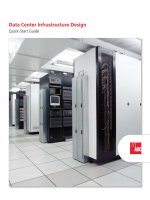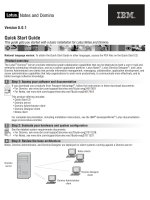Gephi tutorial quick start (2)
Bạn đang xem bản rút gọn của tài liệu. Xem và tải ngay bản đầy đủ của tài liệu tại đây (1.76 MB, 32 trang )
*
*
*
*
*
*
*
*
*
*
*
*
*
*
*
*
Tutorial
Quick Start
Introduction
Import file
Visualization
Layout
Ranking (color)
Metrics
Ranking (size)
Layout again
Show labels
Community-detection
Partition
Filter
Preview
Export
Save
Conclusion
Gephi Tutorial
Quick Start
Welcome to this introduction tutorial. It will guide you to the basic steps of network
visualization and manipulation in Gephi.
Gephi version 0.7alpha2 was used to do this tutorial.
Get Gephi
Last updated March 05th, 2010
*
*
*
*
*
*
*
*
*
*
*
*
*
*
*
*
Tutorial
Quick Start
Introduction
Import file
Visualization
Layout
Ranking (color)
Metrics
Ranking (size)
Layout again
Show labels
Community-detection
Partition
Filter
Preview
Export
Save
Conclusion
Open Graph File
•Download the file
LesMiserables.gexf
•In the menubar, go to File Menu and Open...
Graph Format
-
GEXF
GraphML
Pajek NET
GDF
GML
- Tulip TLP
- CSV
- Compressed ZIP
*
*
*
*
*
*
*
*
*
*
*
*
*
*
*
*
Tutorial
Quick Start
Introduction
Import file
Visualization
Layout
Ranking (color)
Metrics
Ranking (size)
Layout again
Show labels
Community-detection
Partition
Filter
Preview
Export
Save
Conclusion
Import Report
•When your filed is opened, the report sum up data found and issues.
- Number of nodes
- Number of edges
- Type of graph
•Click on OK to validate and see the graph
*
*
*
*
*
*
*
*
*
*
*
*
*
*
*
*
Tutorial
Quick Start
Introduction
Import file
Visualization
Layout
Ranking (color)
Metrics
Ranking (size)
Layout again
Show labels
Community-detection
Partition
Filter
Preview
Export
Save
Conclusion
You should now see a graph
We imported “Les Miserables” dataset1. Coappearance weighted network of
characters in the novel “Les Miserables” from Victor Hugo.
Nodes position is random at first, so you may see a slighty different representation.
1
D. E. Knuth, The Stanford GraphBase: A Platform for Combinatorial Computing, Addison-Wesley,
Reading, MA (1993).
*
*
*
*
*
*
*
*
*
*
*
*
*
*
*
*
Tutorial
Quick Start
Introduction
Import file
Visualization
Layout
Ranking (color)
Metrics
Ranking (size)
Layout again
Show labels
Community-detection
Partition
Filter
Preview
Export
Save
Conclusion
Graph Visualization
•Use your mouse to move and scale the visualization
- Zoom: Mouse Wheel
- Pan: Right Mouse Drag
Zoom
•Locate the “Edge Thickness” slider on the bottom
•If you loose your graph, reset the position
Drag
*
*
*
*
*
*
*
*
*
*
*
*
*
*
*
*
Tutorial
Quick Start
Introduction
Import file
Visualization
Layout
Ranking (color)
Metrics
Ranking (size)
Layout again
Show labels
Community-detection
Partition
Filter
Preview
Export
Save
Conclusion
Layout the graph
Layout algorithms sets the graph shape, it is the most essential action.
•Locate the
Layout module, on the left panel.
•Choose “Force Atlas”
You can see the layout properties below, leave default
values.
•Click on
Layout algorithms
to launch the algorithm
Graphs are usually layouted with “Force-based” algorithms. Their principle is easy, linked nodes
attract each other and non-linked nodes are pushed apart.
*
*
*
*
*
*
*
*
*
*
*
*
*
*
*
*
Tutorial
Quick Start
Introduction
Import file
Visualization
Layout
Ranking (color)
Metrics
Ranking (size)
Layout again
Show labels
Community-detection
Partition
Filter
Preview
Export
Save
Conclusion
Control the layout
The purpose of Layout Properties is to let you control the algorithm in order to make a
aesthetically pleasing representation.
•Set the “Repulsion strengh” at 10 000 to expand
the graph.
•Type “Enter” to validate the changed value.
•And now
the algorithm.
*
*
*
*
*
*
*
*
*
*
*
*
*
*
*
*
Tutorial
Quick Start
Introduction
Import file
Visualization
Layout
Ranking (color)
Metrics
Ranking (size)
Layout again
Show labels
Community-detection
Partition
Filter
Preview
Export
Save
Conclusion
You should now see a layouted graph
*
*
*
*
*
*
*
*
*
*
*
*
*
*
*
*
Tutorial
Quick Start
Introduction
Import file
Visualization
Layout
Ranking (color)
Metrics
Ranking (size)
Layout again
Show labels
Community-detection
Partition
Filter
Preview
Export
Save
Conclusion
Ranking (color)
Ranking module lets you configure node’s color and size.
•Locate
Ranking module, in the top left.
•Choose “Degree” as a rank parameter.
You should obtain the configuration panel below:
•Click on
to see the result.
*
*
*
*
*
*
*
*
*
*
*
*
*
*
*
*
Tutorial
Quick Start
Introduction
Import file
Visualization
Layout
Ranking (color)
Metrics
Ranking (size)
Layout again
Show labels
Community-detection
Partition
Filter
Preview
Export
Save
Conclusion
Let’s configure colors
•Move your mouse over the gradient component.
•Double-click on triangles to configure the color
Palette
Use palette by right-clicking on the panel.
*
*
*
*
*
*
*
*
*
*
*
*
*
*
*
*
Tutorial
Quick Start
Introduction
Import file
Visualization
Layout
Ranking (color)
Metrics
Ranking (size)
Layout again
Show labels
Community-detection
Partition
Filter
Preview
Export
Save
Conclusion
Ranking result table
You can see rank values by enabling the result table. Valjean has 36 links and is the most
connected node in the network.
•Enable table result view at the bottom toolbar
•Click again on
*
*
*
*
*
*
*
*
*
*
*
*
*
*
*
*
Tutorial
Quick Start
Introduction
Import file
Visualization
Layout
Ranking (color)
Metrics
Ranking (size)
Layout again
Show labels
Community-detection
Partition
Filter
Preview
Export
Save
Conclusion
Metrics
We will calculate the average path length for the network. It computes the path length for
all possibles pairs of nodes and give information about how nodes are close from each other.
•Locate the
•Click on
Statistics module on the right panel.
near “Average Path Length”.
Metrics available
- Diameter
- Average Path Length
- Clustering Coefficient
- PageRank
- HITS
-
Betweeness Centrality
Closeness Centrality
Eccentricity
Community Detection
(Modularity)
*
*
*
*
*
*
*
*
*
*
*
*
*
*
*
*
Tutorial
Quick Start
Introduction
Import file
Visualization
Layout
Ranking (color)
Metrics
Ranking (size)
Layout again
Show labels
Community-detection
Partition
Filter
Preview
Export
Save
Conclusion
Metric settings
The settings panel immediately appears.
•Select “Directed” and click on OK to compute the metric.
*
*
*
*
*
*
*
*
*
*
*
*
*
*
*
*
Tutorial
Quick Start
Introduction
Import file
Visualization
Layout
Ranking (color)
Metrics
Ranking (size)
Layout again
Show labels
Community-detection
Partition
Filter
Preview
Export
Save
Conclusion
Metric result
When finished,
the metric displays its result in
a report
*
*
*
*
*
*
*
*
*
*
*
*
*
*
*
*
Tutorial
Quick Start
Introduction
Import file
Visualization
Layout
Ranking (color)
Metrics
Ranking (size)
Layout again
Show labels
Community-detection
Partition
Filter
Preview
Export
Save
Conclusion
Ranking (size)
Metrics generates general reports but also results for each node. Thus three new values
have been created by the “Average Path Length” algorithm we ran.
- Betweeness Centrality
- Closeness Centrality
- Eccentricity
•Go back to
Ranking
•Select “Betweeness Centrality” in the list.
This metrics indicates influencial nodes for highest
value.
*
*
*
*
*
*
*
*
*
*
*
*
*
*
*
*
Tutorial
Quick Start
Introduction
Import file
Visualization
Layout
Ranking (color)
Metrics
Ranking (size)
Layout again
Show labels
Community-detection
Partition
Filter
Preview
Export
Save
Conclusion
Ranking (size)
The node’s size will be set now. Colors remain the “Degree” indicator.
•Select the diamond icon in the toolbar for size.
•Set a min size at 10 and a max size at 50.
•And click on
to see the result.
*
*
*
*
*
*
*
*
*
*
*
*
*
*
*
*
Tutorial
Quick Start
You should see a colored and sized graph
Introduction
Import file
Visualization
Layout
Ranking (color)
Metrics
Ranking (size)
Layout again
Show labels
Community-detection
Partition
Filter
Preview
Export
Save
Conclusion
Color:
Size:
Degree
Betweeness Centrality metric
*
*
*
*
*
*
*
*
*
*
*
*
*
*
*
*
Tutorial
Quick Start
Introduction
Import file
Visualization
Layout
Ranking (color)
Metrics
Ranking (size)
Layout again
Show labels
Community-detection
Partition
Filter
Preview
Export
Save
Conclusion
Layout again
The layout is not completely satisfying, as big nodes can overlap smaller.
The “Force Atlas” algorithm has an option to take node size in account when layouting.
•Go Back to the
Layout panel.
•Check the “Adjust by Sizes” option and run again the
algorithm for short moment.
•You can see nodes are not overlapping anymore.
*
*
*
*
*
*
*
*
*
*
*
*
*
*
*
*
Tutorial
Quick Start
Introduction
Import file
Visualization
Layout
Ranking (color)
Metrics
Ranking (size)
Layout again
Show labels
Community-detection
Partition
Filter
Preview
Export
Save
Conclusion
Show labels
Let’s explore the network more in details now that colors and size indicates central
nodes.
•Display node labels
•Set label size proportional to node size
•Set label size with the scale slider
*
*
*
*
*
*
*
*
*
*
*
*
*
*
*
*
Tutorial
Quick Start
Introduction
Import file
Visualization
Layout
Ranking (color)
Metrics
Ranking (size)
Layout again
Show labels
Community-detection
Partition
Filter
Preview
Export
Save
Conclusion
Community detection
The ability to detect and study communities is central in network analysis. We would like
to colorize clusters in our example.
Gephi implements the Louvain method1, available from the
Click on
Statistics panel.
near the “Modularity” line
•Select “Randomize” on the panel.
•Click on OK to launch the detection.
Blondel V, Guillaume J, Lambiotte R, Mech E (2008) Fast unfolding of communities in large networks. J Stat Mech: Theory Exp 2008:P10008. ()
1
*
*
*
*
*
*
*
*
*
*
*
*
*
*
*
*
Tutorial
Quick Start
Introduction
Import file
Visualization
Layout
Ranking (color)
Metrics
Ranking (size)
Layout again
Show labels
Community-detection
Partition
Filter
Preview
Export
Save
Conclusion
Partition
The community detection algorithm created a “Modularity Class” value for each node.
The partition module can use this new data to colorize communities.
•Locate the
Partition module on the left panel.
•Immediately click on the “Refresh” button to populate the partition list.
How to visualize nodes & edges columns?
See columns and values for nodes and edges by looking at the Data Table view.
Select
Data Laboratory tab and click on “Nodes” to refresh the table.
*
*
*
*
*
*
*
*
*
*
*
*
*
*
*
*
Tutorial
Quick Start
Introduction
Import file
Visualization
Layout
Ranking (color)
Metrics
Ranking (size)
Layout again
Show labels
Community-detection
Partition
Filter
Preview
Export
Save
Conclusion
Partition
•Select “Modularity Class” in the partition list.
You can see that 9 communities were found, could
be different for you. A random color has been set for
each community identifier.
•Click on
to colorize nodes.
Right-click on the panel to access the Randomize colors action.
*
*
*
*
*
*
*
*
*
*
*
*
*
*
*
*
Tutorial
Quick Start
Introduction
Import file
Visualization
Layout
Ranking (color)
Metrics
Ranking (size)
Layout again
Show labels
Community-detection
Partition
Filter
Preview
Export
Save
Conclusion
What the network looks like now
*
*
*
*
*
*
*
*
*
*
*
*
*
*
*
*
Tutorial
Quick Start
Introduction
Import file
Visualization
Layout
Ranking (color)
Metrics
Ranking (size)
Layout again
Show labels
Community-detection
Partition
Filter
Preview
Export
Save
Conclusion
Filter
The last manipulation step is filtering. You create filters that can hide nodes and egdes
on the network. We will create a filter to remove leaves, i.e. nodes with a single edge.
•Locate the
Filters module on the right panel.
•Select “Degree Range” in the “Topology” category.
•Drag it to the Queries, drop it to “Drag filter here”.
Drag
*
*
*
*
*
*
*
*
*
*
*
*
*
*
*
*
Tutorial
Quick Start
Introduction
Import file
Visualization
Layout
Ranking (color)
Metrics
Ranking (size)
Layout again
Show labels
Community-detection
Partition
Filter
Preview
Export
Save
Conclusion
Filter
•Click on “Degree Range” to activate the filter. The parameters panel appears.
It shows a range slider and the chart that represents the data, the degree distribution
here.
•Move the slider to sets its lower bound to 2.
•Enable filtering by pushing the
button.
Nodes with a degree inferior to 2 are now hidden.
Tip
You can edit bounds manually by double-clicking on values.









